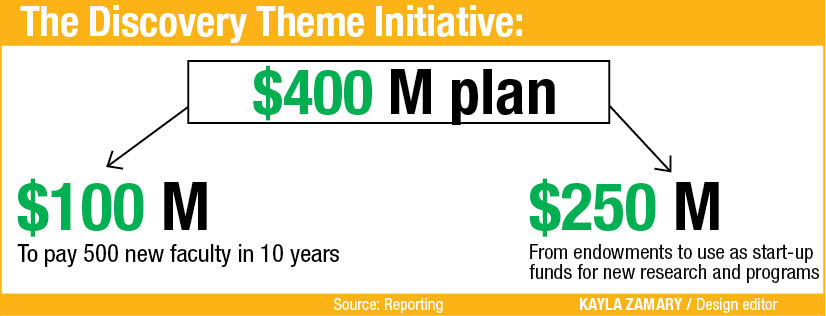
An Ohio State initiative aiming to hire 500 faculty members in the next decade will soon be taking requests for proposals.
The university’s Discovery Themes Initiative, launched in October 2012, is a $400 million plan to expand research and hire new faculty. The initiative focuses on expanding the university’s academic focus in three areas: energy and environment, food production and security, and health and wellness.
Executive Vice President and Provost Joseph Steinmetz told The Lantern the university’s discovery themes seek to “tackle the world’s biggest problems.”
Steinmetz said a major factor in the initiative’s success is getting top professors to OSU by providing competitive salaries and ensuring potential new faculty that OSU can fund their research.
The initiative will begin a request for proposals process this fall, Steinmetz announced in an email to faculty and staff Sept. 4. Steinmetz said in the email he anticipates the request for proposals will bring in new faculty for Fall 2014 and another request for proposals will be made in the spring with the goal of bringing in faculty for Fall 2015.
Faculty advisory boards met during the spring and summer to explore the specific needs in those three areas, Steinmetz said in the email. Representatives from those boards and Steinmetz’s office now plan to meet to prepare the request for proposals.
There will be a set funding amount of each request for proposals, but the figures will not be released until the requests for proposals are finalized, Michael Boehm, vice provost for Academic and Strategic Planning, said in a email Monday.
Boehm added there is no target number of faculty OSU plans to bring in for 2014 and 2015.
“This is not a ‘numbers’ game. Our goal is to attract the best of the best that fits OSU’s needs and who position the university in a forward-leaning position,” he said.
The Discovery Themes Initiative, however, has set a goal of bringing 500 new tenured or tenure-track faculty to the university in the next 10 years, according to the Discovery Themes website.
That goal, though, comes at a time when experts say getting top professors is harder than ever. At OSU’s Aug. 30 presidential symposium, Washington State President Elson Floyd said increasing competition for faculty and research is one of the principal factors driving what he called a “significant transformation” in higher education.
That transformation seems to be driving some universities to shell out in the hopes of keeping their best professors.
“The irony of all of this is that the better faculty you attract and support and nurture and maintain, the more everyone else wants them,” Steinmetz told The Lantern. “So the better faculty we have, we always have other institutions coming in and looking at them.”
The university’s long-term strategy for keeping its faculty, he said, is to foster an attractive environment on campus and to keep salaries competitive.
Interim OSU President Joseph Alutto sent a letter to vice presidents, deans, department chairs and school directors in April detailing OSU merit-based salary increases for current faculty. The plan set an aggregate salary increase of 2 percent, with some faculty receiving more of an raise, some receiving less of an raise and some receiving no increase in pay. That plan also approved bonuses for “exceptional achievement, performance on a project, or leadership shown in the unit,” the memo read.
More money is earmarked for new faculty as part of the Discovery Themes Initiative.
The university will use $100 million to pay new faculty and $250 million from endowments to use as start-up funds for new research and programs. Steinmetz said the plan is for the university to fund programs and research temporarily while trying to secure funding from outside sources like the National Institute of Health and the National Science Foundation.
Securing that funding is key for keeping new faculty at OSU for good, Steinmetz said. He added while the Discovery Themes Initiative is essentially a 10-year plan, the university is also being careful to ensure the gains OSU makes will continue in the long-term.
University Student Government President Taylor Stepp and Vice President Josh Ahart both agree faculty excellence is important, but said student needs should be the priority.
“The tuition freeze was a start, but it’s not enough. I certainly do agree with the idea that we need to be bringing high-performing faculty to this university, but I’m also very mindful of how we utilize our resources, especially considering the rising cost of college and student debt,” Stepp, a fourth-year in public affairs, said.
Ahart agreed.
“Our faculty here at Ohio State are remarkable and they need to be rewarded for what they do, but we also need to keep in mind that for students, we need to keep college affordable. Any way that we can get tuition to be lower and make it easier for families and students to come here, that’s what we have to work on,” Ahart, a fourth-year in public affairs, said.


